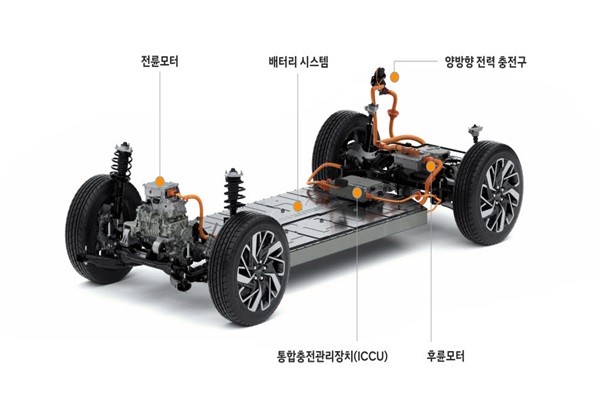Hyundai Motor Group plans to apply wireless charging technology, V2G (Vehicle to Grid) and V2L (Vehicle to Load) systems that allow electricity stored in electric vehicles to be used freely, and 400V and 800V multi-charging and ultra-fast charging function for battery electric vehicles (BEV) that will be released starting from 2021. It will apply its latest technologies that are currently used in various cars.
Hyundai Motor Group held “E-GMP Discovery” event through online channels such as YouTube on Wednesday and introduced its electric vehicle platform E-GMP. E-GMP is the group’s first electric vehicle platform that will become the backbone of the group’s next-generation electric vehicles and it will be the basis of Hyundai Motor Company’s “IONIQ 5”, Kia Motors’ “CV (project name)”, and Genesis Motor’s “JW (Project name)” that will be released in 2021. The platform was developed through the group’s own technology.
Application of E-GMP will allow the group to gain competitive edge in different aspects such as roomy interior space unlike current electric vehicles that are reconstructed based on platforms of gasoline cars, competitive price from improved mass-production, and balanced weight from installation of large-capacity battery.
The biggest characteristic of the group’s next-generation electric vehicles will be their wide interior space that was once occupied by engine, transmission, and fuel tank as the vehicles’ floor will be designed flat unlike gasoline cars.
“Our group plans to expand our leadership in the global electric vehicle market even more by adding new vehicles that require dynamic performance to our excellent efficiency in electric vehicles through a world-class electric vehicle platform E-GMP.” said Albert Biermann who is the head of R&D Division at Hyundai Motor/Kia Motors.
Hyundai Motor Group plans to release various types of vehicles from midsize sedan to high-performance and high-efficient models by utilizing the platform. Eventually, it will even release 7-seater SUVs by expanding the platform.

Electric vehicles that will be released starting from 2021 will be based on the E-GMP platform and applied with the group’s latest technologies.
Some electric vehicles will be applied with wireless charging technology. “Wireless charging technology either requires a device underneath the vehicle that sends electricity after receiving the electricity from an external infrastructure or a vehicle to receive wireless charging directly.” said Jung Jin-hwan who is the director of Hyundai’s electrification development office. “Our group possesses both technologies and we plan to apply wireless charging technology to next-generation electric vehicles although the timing of application can be different depending on a market environment.”
The world’s first 400V/800V multi-charging and ultra-fast charging technology will also be applied to the group’s next-generation electric vehicles.
While electric vehicles that are equipped with 800V high-voltage charging systems require a separate part to use 400V rapid chargers, E-GMP is manufactured so that both ultra-fast chargers and the current rapid chargers can be used at the same time without having to require a separate part. The platform is a type of power control booster technology that utilizes energy remaining in motor and inverter and provides high compatibility in using charging infrastructures. By using an 800V charging system, it is possible to charge 80% in just 18 minutes. In other words, an electric vehicle will have a range of 100 kilometers with 5 minutes of charging.
“Because the E-GMP platform is a modularized and standardized platform, we will be able to expand our electric vehicle lineup in a short period of time depending on customers’ requests and improve our profitability as it improves our production efficiency due to its simplicity.” said a representative from Hyundai Motor Group.
The group’s new electric vehicles will also be installed with V2G and V2L systems. They are able to supply 3.5 kW of electricity, which is more than the contract demand (3 kW) of a normal household, and they are able to operate an air conditioner for a 17-pyeong house and a 55-inch TV for about 24 hours depending on a battery capacity.
Staff Reporter Park, Taejoon | gaius@etnews.com